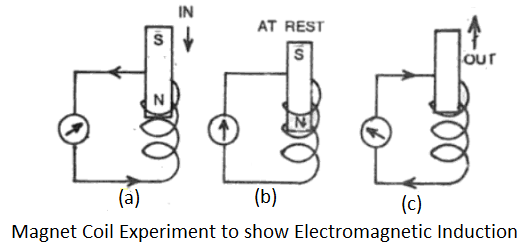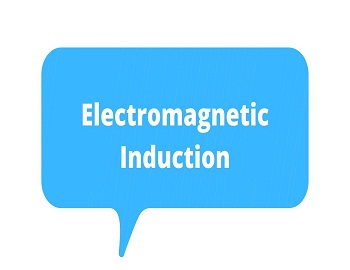Table of Contents
Electromagnetic Induction:
In physics, inverse effects are very common. After Oersted’s discovery in 1820 that an electric current produces a magnetic field in the surroundings, physicists asked the question, “Will a magnetic field produce an electric current”? Among those who considered this question seriously was Michael Faraday. After several years of hard work he could show by experiments in 1831 that whenever the magnetic flux passing through a coil changes, an emf is induced in the circuit and if the circuit is closed, this emf drives a current known as induced current.
The phenomenon of generation of emf and production of current by changing the magnetic flux threading the circuit is known as electromagnetic induction.
The fact that induced emf and current can be produced by changing the flux linked with the circuit can be demonstrated by the coil-magnet experiment and coil-coil experiment as described below-
Coil-Magnet Experiment:

Connect the terminals of a coil wound on a hollow cylinder to a sensitive galvanometer and thrust into it N-pole of a bar magnet. The needle of the galvanometer is deflected showing that an emf is induced in the circuit. The deflection takes place at the instant the magnet is introduced.
It falls to zero again as soon as the movement of the magnet ceases. When the N-pole of the magnet is withdrawn, the needle of the galvanometer is again deflected but in the opposite direction, showing that the polarity of the induced emf is now reversed. By repeating the same operations, it can be established that the induced emf is produced so long as there is a change in the magnetic flux passing through the coil. During the increase in the lines of magnetic flux, an emf is induced in one direction, but during the decrease, it is induced in the opposite direction.
Coil-Coil Experiment:

Take a coil in which another coil could slide. Connect a galvanometer in one solenoid and pass current in the other. The coil in which the source of emf is placed is known as primary and the other as secondary. After establishing the current in the primary if the secondary is brought close or moved away, some deflection is produced in the galvanometer showing that emf has been induced in the secondary.
Induced emf can also be produced in the secondary without producing relative motion between the coils by quickly making or breaking the primary circuit. When the current in the primary circuit is suddenly switched on, deflection is produced in the galvanometer of the secondary circuit, however, when the current in the primary circuit is suddenly switched off, deflection is again produced in the galvanometer but now in the opposite direction.









Comments (No)